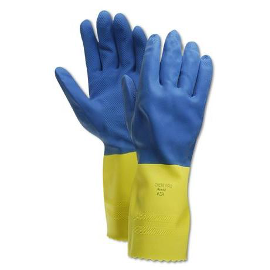Last Revised: March 24, 2025
Original: 12/2019
Acid and base baths are used to clean glassware in synthetic chemistry labs by degrading/dissolving organic compounds and etching glassware. Common contents include 2-propanol, potassium or sodium hydroxide, and sulfuric acid.
Hazard Description
Corrosive chemicals are highly reactive substances that cause obvious damage to living tissue. Corrosives act either directly by chemically destroying the part (oxidation) or indirectly by causing inflammation. Corrosive chemicals can be liquids, solids, or gases and can affect the eyes, skin, and respiratory tract. Acids and bases are common corrosive materials. For more information on corrosives, refer to the Chemical Hygiene Plan SOP on Corrosives, available here.
Alkali injuries to the eyes are more common than injuries from acids and can be more clinically challenging, with a significant potential for long-term morbidity.
Less hazardous alternatives include:
Container Requirements
Acid Bath
Corrosive acid baths such as those used for glassware cleaning must be in an appropriate container with non-sealable lid. The use of buckets or other containers with tight-fitting lids is not permitted as there is a potential for pressurization.
For acid baths, use rectangular or cylindrical containers in the smallest appropriate size. An example of a rectangular compliant product that can be used for acid baths is: Nalgene tank. An example of a cylindrical compliant product can be found here: Nalgene tank.
Base Baths
The use of buckets or other containers with screw-top lids is appropriate for base baths. If buckets are used, remove handles to discourage lifting and pouring.
You may also use the containers listed above for acid baths.
PPE Requirements
Clothing
Standard lab attire, lab coat, full-length pants or equivalent, and fully enclosed shoes. Chemical-resistant apron may be worn over the lab coat to protect against splashes.
Eye & Face Protection
If there is a splash potential, tight-fitting splash goggles are recommended along with a face shield or protection from a hood sash.
Hand Protection
An example glove suitable for acid/base bath work is the Ansell Chemi Pro 224 (27 mil), a neoprene/natural rubber latex combination with forearm protection. It is available for sale in the Penn Chemistry stockroom and is pictured below:

For more information, refer to the Lab Coat, Gloves, and Safety Eyewear Policy, available here.
Labeling Requirements
Acid and base baths should be labeled with the OSHA hazard pictogram and contents. EHRS has templates for the bath labels to use with Avery UltraDuty GHS Chemical Labels 60502.
General Best Practices and Tips
- Glassware must be rinsed thoroughly to remove majority of contamination before putting in acid or base bath.
- Secondary containment may be appropriate, especially if bath is stored on floor.
- Do not lift filled bath.
- Securely cover bath before moving to prevent splashing and exposures.
- Use a siphon pump to empty the bath into waste carboy (Available from EHRS).
- Do not use base baths to clean volumetric glassware (e.g. volumetric flasks). The etching process will alter the volume of the vessel.